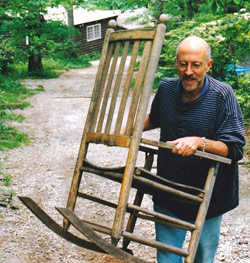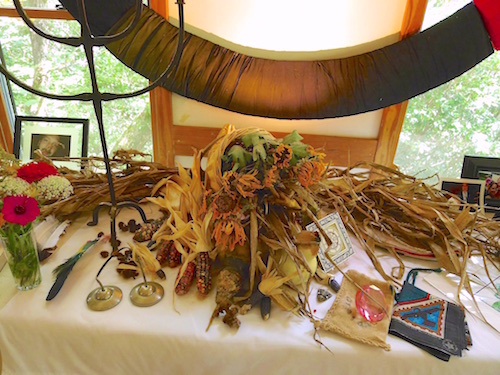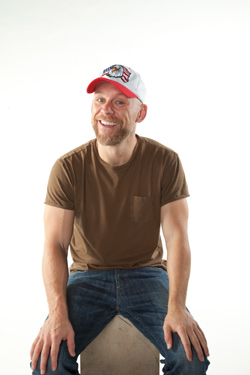This is the second in a series of articles about altars republished from the Visionary archives. It was originally published in the Summer 2001 issue of GSV’s Visionary journal.

Home Altars and a Daily Practice
by King Thackston
Ever since I saw Rebecca Wells’ Ebook, Little Altars, Everywhere, that’s how I tend to think of my home. There are literally little altars, everywhere!
I assembled the main altar in my bedroom a decade ago after my first GSV Conference. But I had been a “closet-altar- kind-of-guy” for years. For a long time the centerpiece was a bronze statue of Kwan Yin, the goddess of mercy but she has moved to the mantle above my bed. Now the center is an oriental wooden temple with a small statue of a wise man on the porch. There is an ever-changing array of candles, blessed water and oils, stones and talismans. The constants are a drawing of the word “love” as if it were written in water and a picture of “The Green Man.”
Above my drawing board is a photograph of a formal Japanese Garden, some hand-made brushes and pencils, a bas- relief of the Egyptian owl, Horus, and a print of the first Zen patriarch/follower of Buddha, Bodhidharma Daruma. He had his eyelids removed when he was caught sleeping during meditation!
On my living room mantle is a candle I light each morning and extinguish each evening before bed. The flame is a remembrance of the spirits of friends who are no longer with me on this plane and a reminder of the gift of life. It reminds me how precious each second is. There is also a small chime that I ring when I light and put out the candle. I also ring it when I leave the house to remind myself to have a safe journey, to accomplish the task successfully and with ease and to have a safe return home. I began this ritual after seeing the Dalai Lama do this before a journey in the movie, “Kundun.” I also think it alerts my guides and angels that I am leaving and reminds them to protect my home and cat, Oskar. A have a toy dome of the ocean with animated dolphins that swim serenely through the sea when you push a plunger. It reminds me to “swim” through the currents of the world and not fight them. Silly, perhaps, but it really puts me in a better frame of mind when I leave my “world” and face the other one outside. This simple act lets me swim/dance with the world instead of pushing against it.
 My daily practice is Yoga, breathing, Chi Gung, meditation and Planetary Acupuncture. Decades ago I studied Yoga with the Pierce Program in Atlanta with Martin Pierce’s first Men’s Class. Then for several years I attended a “Wellness Workout” taught by Jean Dunham that combined breathing, stretching, Skinner Releasing and dancing. Here I was also introduced to the Tao Animal Exercises in which you “become” different animals to energize different body systems.
My daily practice is Yoga, breathing, Chi Gung, meditation and Planetary Acupuncture. Decades ago I studied Yoga with the Pierce Program in Atlanta with Martin Pierce’s first Men’s Class. Then for several years I attended a “Wellness Workout” taught by Jean Dunham that combined breathing, stretching, Skinner Releasing and dancing. Here I was also introduced to the Tao Animal Exercises in which you “become” different animals to energize different body systems.
Around is time at an early GSV Fall Conference, George Miller taught me Chi Gong wake- up exercises. Rocco Patt taught Planetary Acupuncture at another GSV Conference. This is a series of breathing exercises involving breathing the universe down though the top of your head and wrapping it around your heart. You breathe it out, down into the center of the Earth. Then, repeat in reverse, breathing the Earth up into your heart and then out the top of your head into the universe. Finally, you pull the third breath into your heart from both directions, wrapping it around your heart and then breathing it out in all directions. Now I do my own routine, mostly- based on all these sources.
It doesn’t take long for a daily practice to become a habit, especially when the benefits begin to appear and it feels integrated into my life.
During the last year, I have learned and benefitted from the regular GSV Yoga classes taught by Rocky Beeland and Sterling McVay.
This article was originally published in the Summer 2001 issue of GSV’s Visionary journal.
Read the original article in the Visionary >>






 “Buddy Wakefield aims to cause a disarming de-haunting of accidents. He is pursuing a career in judgment suspension but sometimes wants to blend in so badly he forgets his purpose and worries that everyone else is doing it right, or wrong. He once sat on top of the whole world and told it jokes about the ocean until everybody crumbled into tattoos of bakeries. It smelled good. Felt right. We laughed. So much. Sometimes, he studies propellers because they can make themselves invisible. Buddy has collected enough humongous titles to be crushed under their weight. There are no stunt doubles performing the accidents in his work, or the bursts of beast in his behavior. There is a recurring theme in his nightmares where he wakes up only to realize that whatever supposedly awful thing was stalking him was really just trying to help. His interests include cephalopods, chopping wood and untrembling, unless trembling is imperative to a successful dance move.”
“Buddy Wakefield aims to cause a disarming de-haunting of accidents. He is pursuing a career in judgment suspension but sometimes wants to blend in so badly he forgets his purpose and worries that everyone else is doing it right, or wrong. He once sat on top of the whole world and told it jokes about the ocean until everybody crumbled into tattoos of bakeries. It smelled good. Felt right. We laughed. So much. Sometimes, he studies propellers because they can make themselves invisible. Buddy has collected enough humongous titles to be crushed under their weight. There are no stunt doubles performing the accidents in his work, or the bursts of beast in his behavior. There is a recurring theme in his nightmares where he wakes up only to realize that whatever supposedly awful thing was stalking him was really just trying to help. His interests include cephalopods, chopping wood and untrembling, unless trembling is imperative to a successful dance move.”